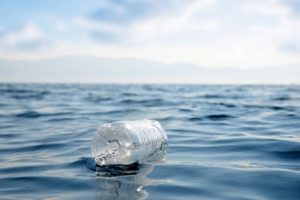What is Reverse Osmosis?
Reverse Osmosis is the process that removes solid substances, minerals, and foreign contaminants from unfiltered or tap water. The reverse osmosis process eliminates chemicals, sediment, and inorganic materials like chlorine, salts, and minerals, also known as TDS or Total Dissolved Solids.
As pollution increases, more chemical contaminants are seeping into our water supply, such as pesticides, PFAS, cleaning products, and even pharmaceuticals requiring enhanced filtration to ensure the cleanest, purest and safest water available. Reverse Osmosis is the most common and affordable way to transform tap water into high-quality purified drinking water. Many popular store-bought bottled water companies use reverse osmosis technology to purify their bottled water.
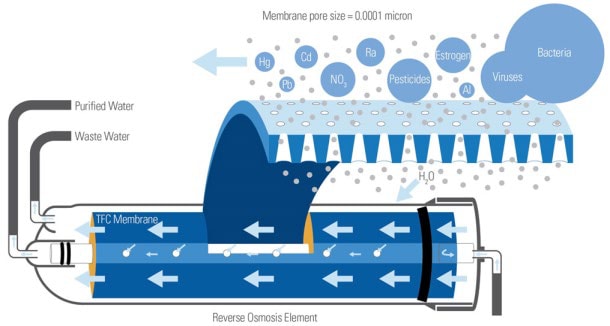
What is TDS or Total Dissolved Solids?
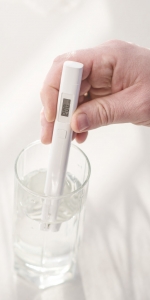
Total dissolved solids are the measurement of all dissolved organic and inorganic compounds combined in water. Anything in water other than pure H2O molecules is considered a TDS.
The amount of TDS is determined by an instrument (TDS ) meter that measures the ability of water to conduct electricity. As the concentration of inorganic compounds increases, water becomes a better conductor of electricity. The inorganic particles produce more electricity in the natural water. Highly purified water produces less electricity and increases resistance. Resistance is used as an indicator of water purity.
The Canadian Safe Water guideline allows a TDS of 500 mg/L or less for municipal tap water. However, some areas are known to have undesirable issues at levels as low as TDS of 100-200 mg/L. Even at levels less than the guidelines, as total dissolved solids increase, water becomes less thirst-quenching and can take on an unpleasant bitter, salty, or metallic taste. It can also produce an undesirable odor. Any tap or well water with increased TDS levels that make water less desirable or palatable would greatly benefit from using a Reverse Osmosis Water Filtration System.
Approximately 90% of all dissolved solids are present as heavy metals or minerals: magnesium, sodium, chloride, sulfates, and carbonates. A small percentage of these inorganic chemicals and heavy metals can cause health issues, and some can even be toxic.

Your water may look clean, but municipal and well water must be treated with harsh chemicals such as chlorine, chloramine, muriatic acid, algaecide, and soda ash, to produce tap water. At times these chemicals are more noticeable, and tap water may smell or taste of chlorine, making it less palatable for drinking or cooking. Although tap water is regulated and deemed safe to drink, even small amounts of chlorine and other water treatment chemicals can lead to health issues over time.
Without further filtration, tap water may still contain dangerous chemicals and heavy metals that also pose serious health risks. Unnatural levels of TDS can accumulate in well, lakes, and municipal water because of human activity.
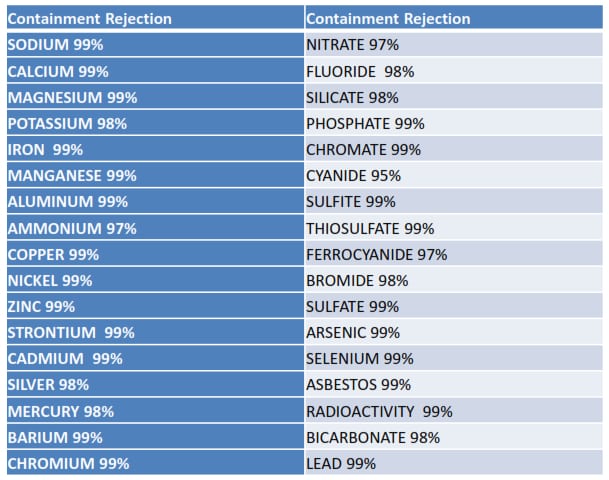
All these contaminants have a negative impact on the environment, like creating blue-green algae blooms, which can only be removed through Reverse Osmosis or Nanofiltration. Ingesting these contaminants can lead to both acute and chronic health effects, including cancer. A reverse osmosis water purification system provides highly filtered pure water that is clean, great-tasting, and most importantly, safe. The RO water purification system removes these harmful inorganic chemicals and minerals. In addition, and a crucial fact, the reverse osmosis system purifies the water without using any chemicals!
In some areas, water may be heavily contaminated or have an offensive taste or odor, in which case a Whole Home Reverse Osmosis Water Purification System can be installed, providing pure RO water throughout the entire house. It supplies pure, clean water not only for drinking but also for cooking, bathing, pets, plants, and even laundry.
Since water dissolves more substances than other liquids, it is particularly vulnerable to contamination. Some water sources are contaminated naturally from organic sources like rocks, soil, and decaying vegetation, while other contaminants are manufactured. Residential, industrial, and agricultural activities all release toxic substances into the environment, which enter lakes, streams, and oceans. These substances range from PFAS (“forever” chemicals) and radioactive waste to pesticides and pharmaceuticals.
How does the Reverse Osmosis Process Work?
It helps to understand the process of Osmosis. Osmosis is the diffusion of water molecules through a Thin-Film Composite (TFC) semipermeable where a low concentration solution naturally moves to a high concentration solution until the osmotic pressures are balanced.
Reverse Osmosis works in reverse by using household water pressure pushing the tap water through a Thin-Film composite semipermeable membrane that blocks the passage of dissolved solids or contaminants. The RO semipermeable membrane separates and holds the highly pure freshwater (the permeate) while 99% of the impurities ( the contaminants) are filtered out and flushed down the drain. For example, the process of desalination of ocean water uses RO technology by pushing saltwater molecules through a reverse osmosis TFC membrane removing and discarding the salt, leaving only pure H2O.

How Does a Reverse Osmosis System Work?
Feedwater from a cold water supply line enters the Reverse Osmosis Pre Filter first. There are two pre-filters: sediment and carbon. The Sediment filter protects the RO membranes by removing sand, silt, dirt, and other sediments that could clog the system. The Carbon filter is utilized to remove chlorine which will damage the RO membrane.
The Reverse Osmosis Semipermeable Membrane is the heart of the system. The semipermeable membrane is designed to remove a wide variety of both aesthetic and health-related contaminants. After the tap (feed) water is pushed through the membrane, the water goes into a pressurized storage tank, where treated water is stored.
The standard RO storage tank holds 2,5 gallons of water when full. A bladder inside the tank keeps water pressurized when it is full.
After the water leaves the RO tank, prior to end-use, the treated water goes through a post polishing filter. The post-filter is a carbon filter. This filter removes any remaining tastes or odors.
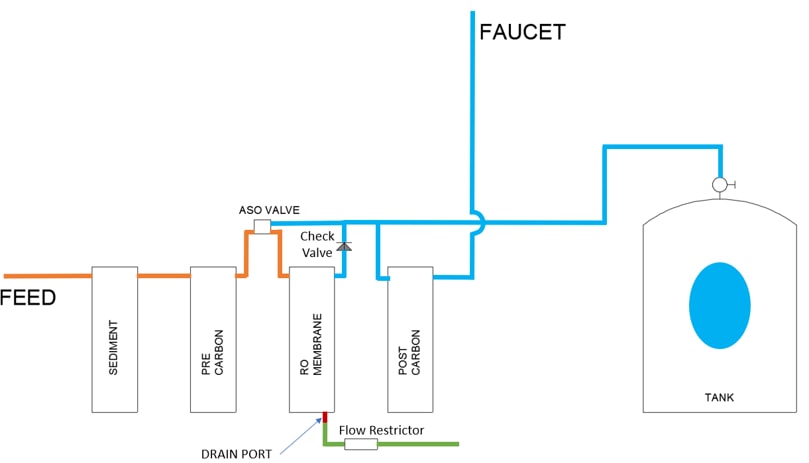
What are the components of a Reverse Osmosis Filtration System?
- Cold Water Supply Line: This is the water source for the RO system, which connects to the cold water line.
- Pre-Filters: The cold supply line water enters the RO pre-filters first. There are two pre-filters. The Sediment filter removes silt, sand, dirt, and other sediments that could clog the system. The Carbon filter removes Chlorine which will damage the RO membrane.
- Reverse Osmosis Membrane: Removes a wide variety of both aesthetic and health-related contaminants.
- Post Filters: Carbon filters that remove any remaining odor or taste containing contaminants. They provide the final “polishing” filtration.
- Automatic Shut off Valve: When the RO storage tank is full, the valve automatically shuts off to conserve water. If the pressure in the tank drops, the valve opens to allow more RO water in the tank, and the contaminated water flows away and down the drain.
- Check Valve: The check valve stops the backflow of the treated water from the RO storage tank, ensuring only pure water remains in the tank.
- Flow Restrictor: This helps regulate and maintain the flow rate and pressure required to provide the highest quality drinking water.
- Storage Tank: The storage tank holds from 2.0 to 4.0 gallons of water when full. The typical Reverse Osmosis tank is 12 inches in diameter and 15 inches tall. A bladder in the tank keeps water pressurized when the tank is full. Some newer RO units do not require a storage tank.
- Faucet: The RO unit uses a separate faucet of its own and is usually installed on the kitchen sink.
- Drain Line: The drain line disposes of the wastewater containing the contaminants and impurities filtered out by the RO system.
- Drain Clamp: The drain clamp connects the drain line of the RO System to the sink drain line and should be installed between the sink and the trap.
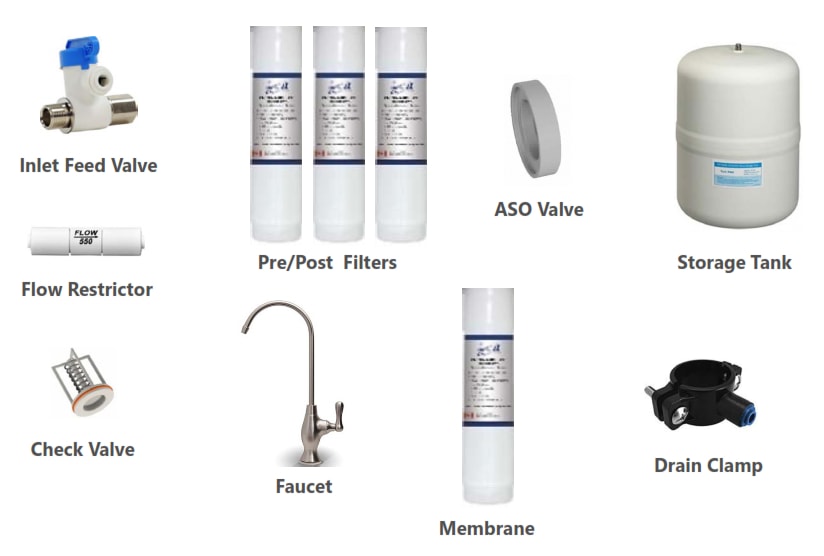
What are the Benefits of Reverse Osmosis?
- Removes 99% of harmful chemicals and contaminants
- Removes Lead
- Removes Arsenic
- Removes E. Coli
- Removes bacteria
- Removes chlorine
- Removes Voc’s
- Reduces Sodium
- Less expensive than buying bottled water
- Removes toxins from the body
- Is better for cooking
- Looks crystal clear and tastes delicious
- Can be hooked up to the water dispenser and ice-maker
- Good for pets and plants
- Excellent moisturizer for hair, skin, and anti-aging
- Makes crystal clear ice cubes
- No chemicals are used with RO filtration systems
- Energy-efficient, RO systems do not require electricity
- Removes 99% of harmful chemicals and contaminants
- RO water filtration is green and clean for the environment
- Easy to install and maintain.
Is reverse osmosis water safe to drink?
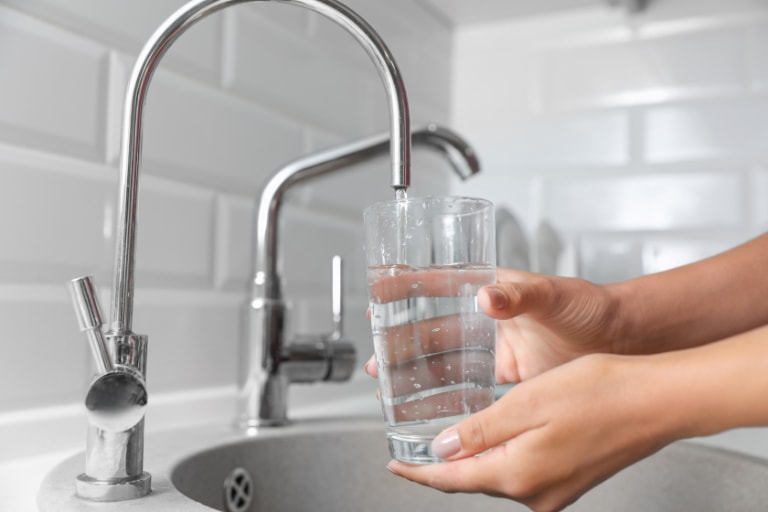
An RO water system provides the safest and healthiest drinking water by removing organic and inorganic contaminants, including trace minerals. It is a common misconception that RO water causes mineral depletion in our bodies, but this is not the case. Only trace amounts of minerals occur in unfiltered water, providing only a minute amount of minerals.
Most minerals needed for human health come from our diet in the foods we eat or mineral supplementation if very deficient. Therefore, the daily recommended 8- 10 glasses of water would not come close to providing the necessary daily mineral intake.
Drinking enough Reverse Osmosis purified water can improve your health and well-being. The organs in your body need enough water to achieve optimal health. Water helps support blood volume, which maintains your energy. Proper hydration improves your concentration and reaction time, especially during exercise. Water increases the number of calories you burn during regular daily activities.

Increased water consumption reduces the excess sodium that can cause fluid retention, and Reverse Osmosis Purified Water helps protect against a variety of ailments such as:
Colds
Constipation
Urinary Tract Infections
Kidney Stones
Bladder Cancer
Also important is the fact that a Reverse Osmosis system removes the harmful water treatment chemicals such as chlorine and toxic trace minerals such as Lead, Arsenic, and Fluoride that are often present in municipal, well, and tap water. As a result, pure RO water provides some of the cleanest, purest, and healthiest drinking water available.
Which Reverse Osmosis System is Right for My Home?
There are various Reverse Osmosis Water Filtration Systems available, each providing the best filtration with high-quality pure drinking water. Some key differences in Reverse Osmosis Filtration Systems are the amount of water filtered daily, measured in gallons per day (gpd), the number of stages per RO system, and the quality of components used in each RO system.
Residential Reverse Osmosis water filtration systems are designed for installation under the sink or basement and are known as point-of-use (POU). Under the sink units provide reverse osmosis water to an added RO kitchen faucet and can also connect to your refrigerator and ice maker.
Reverse Osmosis Water Filtration Systems are designed with varying stages. The number of stages is determined by the number of pre and post-filters added to provide maximum filtration. Several Reverse Osmosis systems are available, from a base 3-stage unit with the essential carbon pre-filter and the semipermeable membrane to a 5/6 stage unit that includes a post-polishing filter. There is also a 7 stage unit that provides post polishing filtration and a Booster Pump that adds a boost of pressure to produce more RO water.
With many RO system options, you can easily choose a customized system that is right for your home. A few added features of Reverse Osmosis systems are that they do not require electricity, making them very energy efficient. Also, Reverse Osmosis units are generally very quiet running systems.
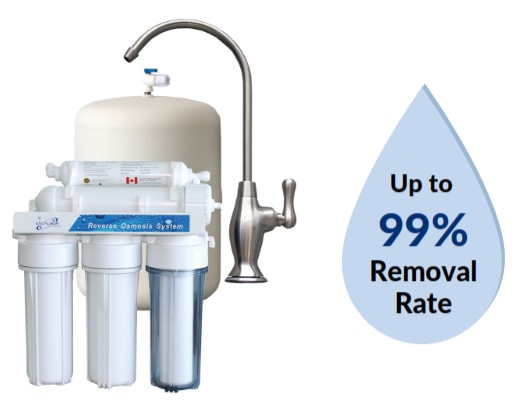
New reverse osmosis technology now offers a tankless RO system with added features such as leak detect and cartridge change alerts. This new technology produces even more fresh pure RO water without the need for an under-the-sink storage tank.
Ensuring your home has the purest drinking water is vital, but a Whole Home Water Filtration System offers even further protection by providing the cleanest crystal-clear pure water throughout your home.
Up to 80% of the human adult body is water. It’s something we all use and consume every day, whether that be when we drink a glass of water, take a shower, or wash vegetables before dinner. Contaminants present in your water supply can enter your body through ingestion or absorption when showering/bathing.
With water being such an integral part of our everyday lives, it’s crucial that the water in your homes is clean and pure. Having a Whole Home Reverse Osmosis System ensures you are choosing the safest and purest water available throughout your home and providing many health benefits now and in the future.
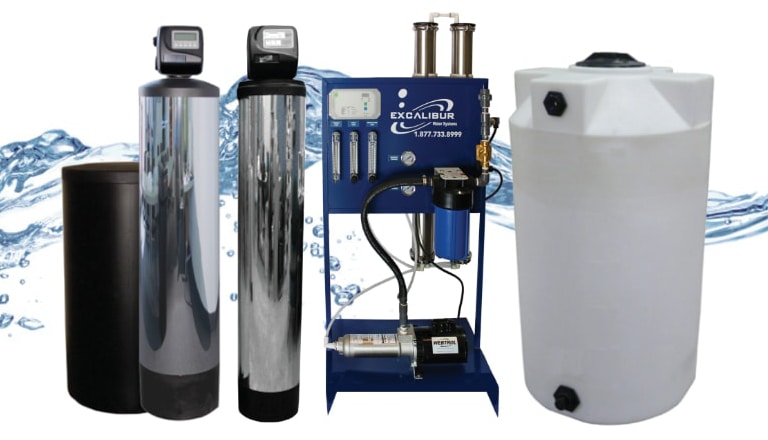
How long will a Reverse Osmosis System last?
Reverse Osmosis Systems generally last between 10-15 years. The systems themselves have a long lifespan, but the RO filters and membranes will need to be replaced periodically. To keep your system in excellent working order, pre and post-filters should be changed every six months to 1 year, and the RO semipermeable membrane should be changed every 2 to 4 years, depending on your water conditions.
A Reverse Osmosis Water Filtration System will provide you with the cleanest drinking water and even better-tasting food rinsed and cooked with filtered water.
Water is an essential part of life. As pollution increases and more chemicals are needed to treat municipal tap water, it is more vital than ever to invest in the purest water available for your home and family.
A Reverse Osmosis System is the best and most widely used system on the market today and is also the most economical! They are compact, quiet units and are easy to install. Enjoy the peace of mind that comes from knowing that you are receiving the highest purity of drinking water available.
For more information about reverse osmosis or Excalibur Reverse Osmosis Systems, please contact us.


